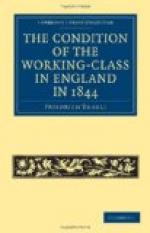It may not be out of place to make some general observations just here as to the customary construction of working-men’s quarters in Manchester. We have seen how in the Old Town pure accident determined the grouping of the houses in general. Every house is built without reference to any other, and the scraps of space between them are called courts for want of another name. In the somewhat newer portions of the same quarter, and in other working-men’s quarters, dating from the early days of industrial activity, a somewhat more orderly arrangement may be found. The space between two streets is divided into more regular, usually square courts.
These courts were built in this way from the beginning, and communicate with the streets by means of covered passages. If the totally planless construction is injurious to the health of the workers by preventing ventilation, this method of shutting them up in courts surrounded on all sides by buildings is far more so. The air simply cannot escape; the chimneys of the houses are the sole drains for the imprisoned atmosphere of the courts, and they serve the purpose only so long as fire is kept burning. {55} Moreover, the houses surrounding such courts are usually built back to back, having the rear wall in common; and this alone suffices to prevent any sufficient through ventilation. And, as the police charged with care of the streets, does not trouble itself about the condition of these courts, as everything quietly lies where it is thrown, there is no cause for wonder at the filth and heaps of ashes and offal to be found here. I have been in courts, in Millers Street, at least half a foot below the level of the thoroughfares, and without the slightest drainage for the water that accumulates in them in rainy weather! More recently another different method of building was adopted, and has now become general. Working-men’s cottages are almost never built singly, but always by the dozen or score; a single contractor building up one or two streets at a time. These are then arranged as follows: One front is formed of cottages of the best class, so fortunate as to possess a back door and small court, and these command the highest rent. In the rear of these cottages runs a narrow alley, the back street, built up at both ends, into which either a narrow roadway or a covered passage leads from one side. The cottages which face this back street command least rent, and are most neglected. These have their rear walls in common with the third row of cottages which face a second street, and command less rent than the first row and more than the second.




